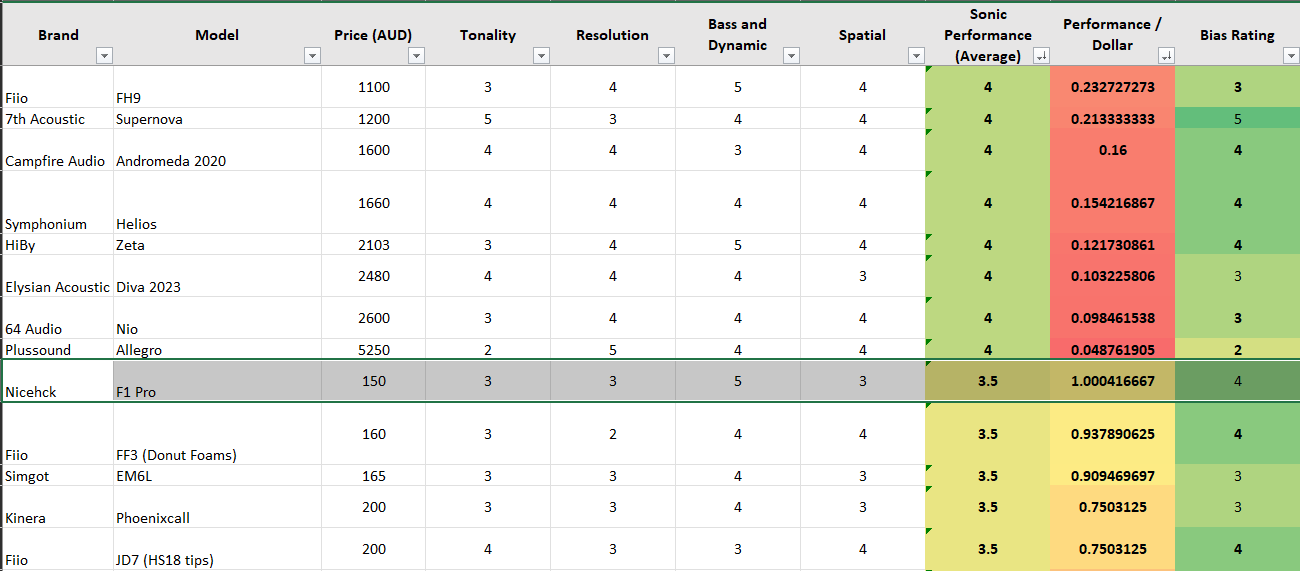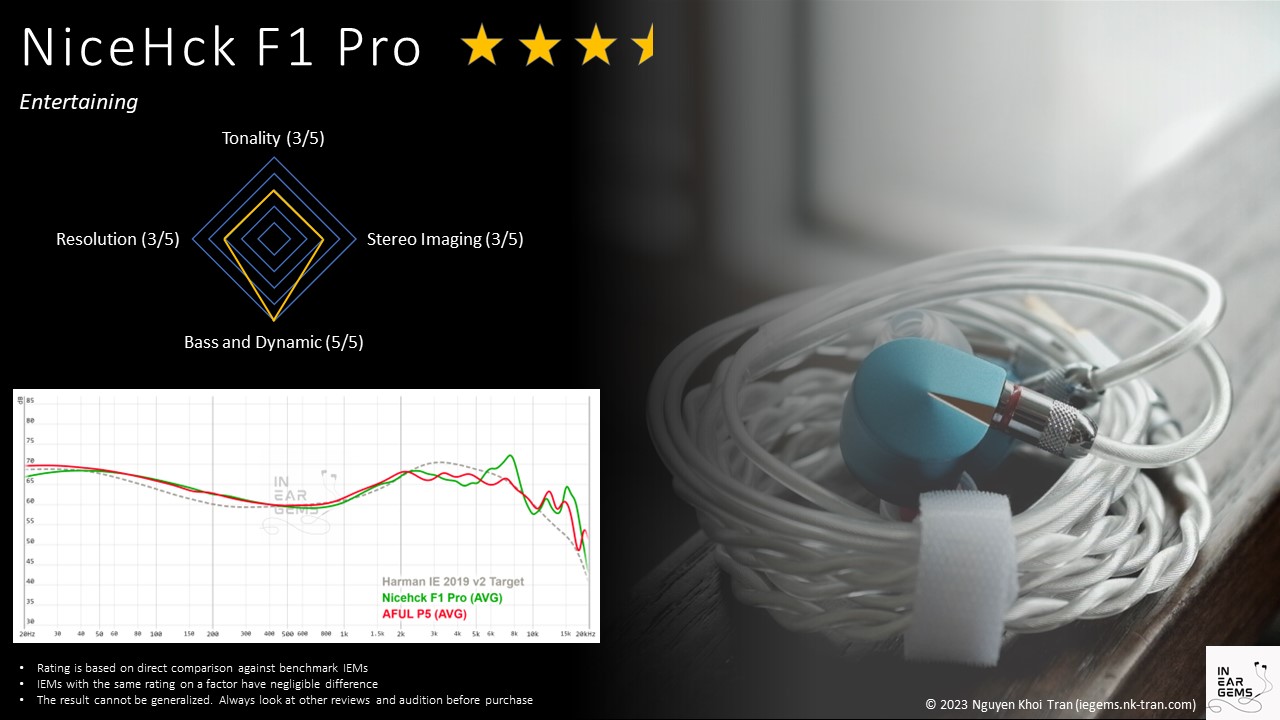NiceHck F1 Pro - Entertaining
Planar magnetic drivers in IEMs. The driver configuration that I have been so desperately trying to love, yet I have been left wanting again and again. Can the new entry to the rank of planar magnetic, NiceHck F1 Pro, change this predicament? Let’s find out.

Forewords
- What I look for in an IEM is immersion. I want to feel the orchestra around me, track individual instruments, and hear all of their textures and details. I’m not picky about tonality, as long as it does not get in the way of immersion.
- I rate IEMs within with a consistent scale from 1 (poor) to 3 (Adequate) to 5 (outstanding). Ratings are assigned by A/B tests against benchmark IEMs, regardless of the retail price.
- Ranking list and measurement database are on my IEM review blog.
- Terms used in my reviews are consistent with the glossary by Headphonesty
- This review is based on a review sample from NiceHck (Thank you!). I have no affiliation with or financial interest in NiceHck.
- The unit retails for $99 at the time this review was published. Unaffiliated link
Testing setup: Local FLAC files -> iBasso DX300 (stock player app) -> stock cable (4.4mm) -> IEM -> stock ear tips (wide bore, thick core)
Packaging and Accessories
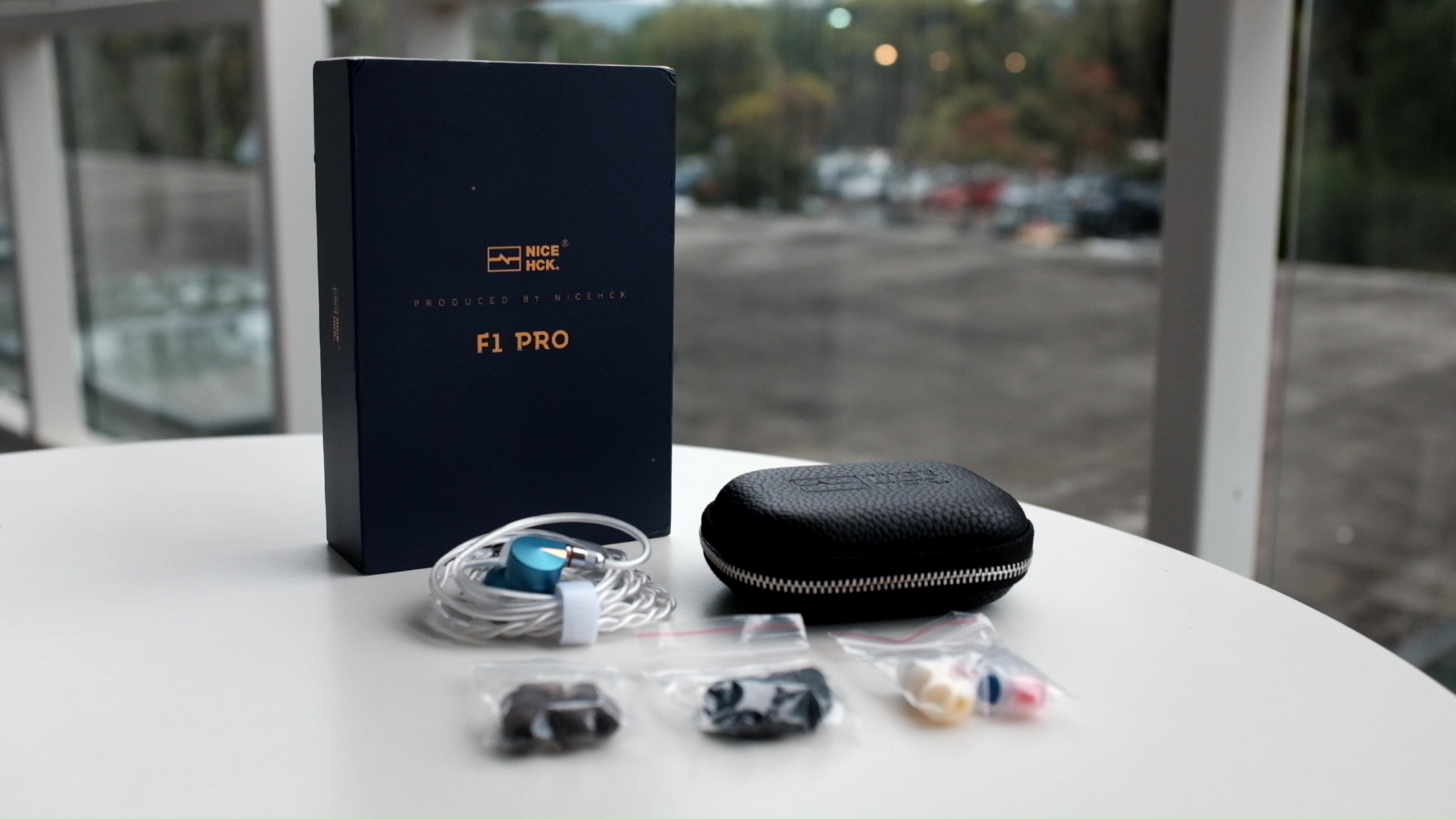
Whilst I have bought many cables from NiceHck, F1 Pro was the my first IEM from this manufacturer. I was pleasantly surprised by the simple yet elegant design of the packaging and the provided accessories. Inside the box, you would find three types of ear tips, all of which can introduce noticeable changes to the sound signature of the IEM, particularly in the treble and bass region. I highly recommend that you try all of the provided tips to find the ones that best suits your ear anatomy and sonic preference.

The stock cable was also well designed. The chrome plated hardware fits the overall aesthetic of F1 Pro well. I am particularly happy that the 2-pin connectors sit flush against the ear pieces. Not many stock cables provide this flushed fit, even when they come from manufactures well known for cable making. The wires themselves are mostly well-behaved. Subjective Experience ===
As usual, our discussion of subjective experience starts with fit and comfort. Luckily, this section will be short: F1 Pro is simply “average.” The nozzles have average width and length that comfortably fit most ear tips besides the narrower ones like Final Type E. As a result, the F1 Pro does not create pressure hot spots within the ear canals in long listening sessions. The part of the earpieces resting against the ears is circular in shape without any edge or contour, so F1 Pro does not stress the outer ears. Moreover, you can tweak the angle of the nozzles by twisting the earpieces forward or backwards.
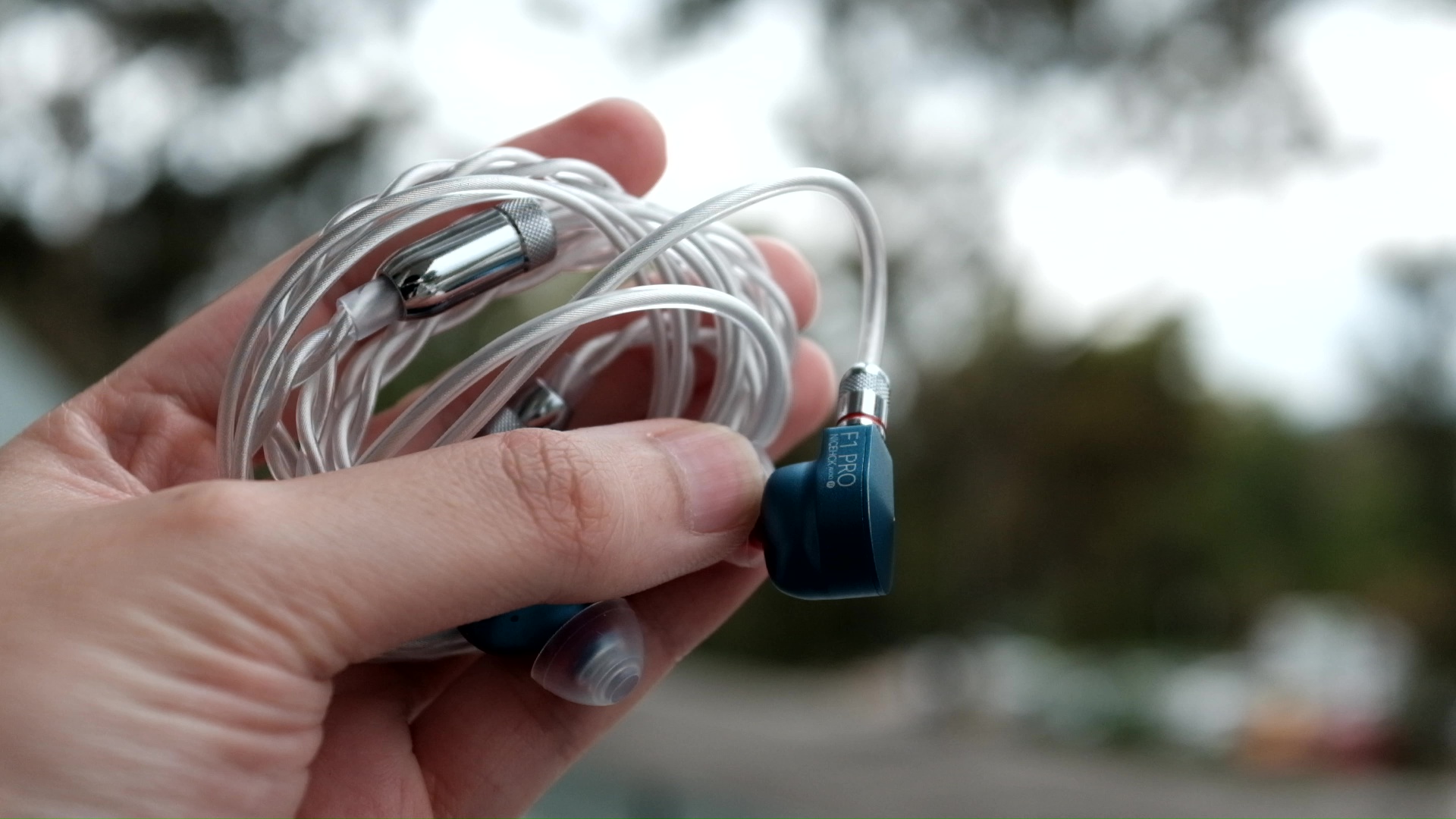

Due to the shape of the F1 Pro, your fit and comfort would depend almost entirely on your choice of ear tips. I found F1 Pro respond well to changing ear tips. To my ears, the bass of F1 Pro becomes thicker and more punchy, with the stock ear tips having a dense core and wide opening. Ear tips with softer cores, like the SpinFit CP100, reduce the perceived “density” of the bass. Moreover, longer ear tips like these CP100 can lengthen the distance between the earpieces and your eardrums, which creates the illusion that the soundstage is more spread out. As usual, every choice is a trade-off you must experiment with and decide for yourself. I opt for CP100 in medium size for the rest of this review.
Now, let’s talk about how F1 Pro sounds.
The overall theme of the sonic performance of F1 Pro can be summarised as “entertaining.” This IEM excels at reproducing percussive instruments such as drums and pianos with clear note attacks. Fingerstyle guitar tracks also sound great. These instruments play to the strength of F1 Pro, which combines having a decent amount of bass and the ability to rapidly reproduce volume swings (transients).
For example, the bass line in the iconic soundtrack of Persona 4, “Heartbeat, Heartbreak”, is ever so satisfying with F1 Pro. Every beat has a crisp attack edge and pleasing physical impact above “neutral” without overpowering the rest of the frequencies. As a result of the tonal balance, the F1 Pro does not sound closed off and congested, a problem that some bass-heavy IEMs can face.
At the same time, the decay end of the bass note is rich in texture and details. In particular, the decay of the bass sounds like “brrrrm” rather than “ummmm”. If I pay attention, I can also pick out the pitch of the bass notes rather than simply low-pitched rumbles.
GOAT by Polyphia is another piece that plays well with the strength of F1 Pro. This complex piece has everything: all sorts of percussive sounds layering upon each other, big bass drops, and the sense of ambience and distance created by the outermost background layer of the mix. F1 Pro can handle the complexity easily and stands up to critical listening well. In fact, it performs the instrument definition and separation so well that I needed to stop my listening session to bring out the “big guns” for comparison. We will discuss the result of such a comparison later in this review. The only aspect I dock points from F1 Pro is the soundstage imaging. It does not spread the instruments out and push the background far enough to create a holographic sensation in sections such as around the 1:10 mark.
Another area where F1 Pro loses ground is the handling of flowing, legato instruments and musical passages. Similarly to a few other planar IEMs I have tested, F1 Pro still has that ever-so-slightly edginess midrange and metallic timbre that does not stand up to critical listening.

For example, let’s listen to “Can’t Help Falling in Love” by Pentatonix in their PTX Vol. IV album. On the plus side, F1 Pro does an outstanding job at separating and layering, ensuring that every vocal line has clarity and clear separation from others. On the other hand, no matter how I try, I cannot convince myself to enjoy the vocals due to the ever-so-slightly cold and stiff reproduction. It’s not a tuning problem. When I swapped Effect Audio Gaea, an IEM notorious for having a bright and lean tonality, I found an extra layer of richness that makes the vocals sound “full.” Interestingly, I found F1 Pro to be more sibilant than the notorious Gaea in this track.

As another example, I listened to the Goldberg Variations transcription for Violin, Viola, and Cello performed by Julian Rachlin, Nobuko Imai, and Mischa Maisky. Again, whilst F1 Pro does not colour the instruments incorrectly in any way, that intangible metallic timbre prevents the strings from being truly enjoyable.
To be clear, these observations do not mean that F1 Pro is incompatible with vocals and acoustic music. It is perfectly alright, though I would not actively pick F1 Pro for this part of my library. For the more upbeat part of my library, F1 Pro is a preferred choice.
Frequency Response Analysis
Frequency response of F1 Pro against AFUL P5 the Harman in-ear target. Measurements were done with an IEC-711-compliant coupler and might only be compared with other measurements from this same coupler. Visit my graph database for more comparisons.
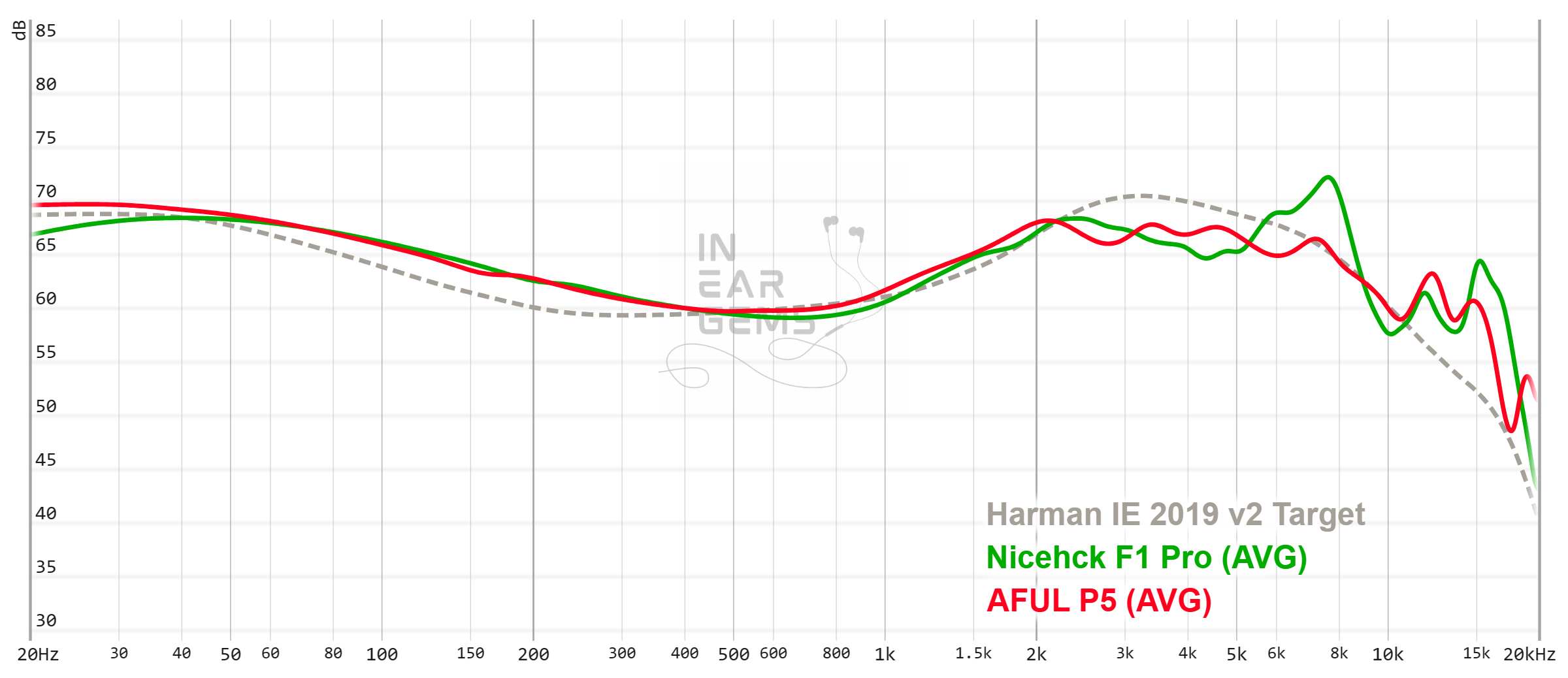
It is helpful to think of an IEM as a filter that highlights or subdues different parts of the incoming audio signal. This effect can be measured objectively by the squiggly lines above, called Frequency Response (FR) graphs, which measure how loud an IEM is at different frequencies from 20Hz (bass) to 20kHz (upper treble). Subjectivity is how your ears and brain interpret the effect of that filter on your music and decide whether it is “enjoyable.” There are some “rules of thumb” when it comes to tonality, but most interesting IEMs usually bend the rules masterfully.
The tonal balance of F1 Pro suggests that it does not fall far from the Harman root. The measurements confirm the observation.
Similarly to most Harman-inspired IEMs that sound good, F1 Pro fills in the dip around 250Hz of the Harman target to prevent the bass from being disconnected from the rest of frequencies and avoid the thin tonality of “true” Harman IEMs. Unlikely the recently reviewed Simgot EM6L, F1 Pro also reduces the energy around the 3kHz and 5kHz region from the Harman target, trading vocal clarity for a more comfortable and less harsh presentation.

Interestingly, when these characteristics are combined, we have a tonal balance almost identical to the AFUL Performer5 (P5). Almost.
Where F1 Pro deviates significantly from the Harman target and P5 is the substantial boost in the mid-treble region between 6kHz and 8kHz. This 5dB difference is significant enough to necessitate a few minutes of adjustment whenever I switch from F1 Pro to P5. This peak also gives a sharp edge to the presentation of F1 Pro that does not exist with P5. The perception of the crisp transient response of F1 Pro likely stems from this treble peak. You can add an 8kHz peak on your IEM using EQ software and check the result.
Resolution

Resolution is a fascinating subject due to the difficulty of pinning down what it really is. To me, “resolution” can be broken down into three components: (1) Sharpness, incisiveness, or “definition” of note attacks (see the figure above). (2) The separation of instruments and vocals, especially when they overlap on the soundstage. (3) The texture and details in the decay side of the notes. The first two give music clarity and make it easy to track individual elements of a mix. The last provides music details and nuances. Smooth and well extended treble response plays a crucial role.
As I alluded to in the subjective impressions, F1 Pro has good resolution. The question is, “How good?”
To answer this question, I compare F1 Pro against Moondrop Blessing 2 and Campfire Audio Andromeda 2020, the two IEMs serving as benchmarks for good (3/5) and great (4/5) resolution. For this test, I would listen to G.O.A.T. by Polyphia.

The listening tests were straightforward but no less surprising. Despite having noticeably more emphasis on the attack edge of all musical notes, F1 Pro does not offer stronger clarity or separation than Blessing 2. At the same time, the nuances and details of all instruments and the background ambience of F1 Pro noticeably suffer in direct comparison against the Andromeda.
Based on this result, I would consider the resolution of F1 Pro to be “Good.” Still, the way F1 Pro renders transients makes it seem more impressive than the other two without direct comparison. Thus, I wouldn’t bat an eye if you find the resolution of F1 Pro to be rather great.
Soundstage Imaging

Stereo imaging or “soundstage” is a psychoacoustic illusion that different recording elements appear at various locations inside and around your head. Your brain creates based on the cues in the recording, which are enhanced or diminushed by your IEMs, your DAC, and your amplifier. Some IEMs present a wide but flat soundstage. Some present a “3D” soundstage with layering, depth, and height. In rare cases, with some specific songs, some IEMs can trick you into thinking that the sound comes from the environment (a.k.a., “holographic”)
Where does F1 Pro sit on the “IEGems soundstage imaging scale”? To answer this question, I again relied on the Blessing 2 (3/5) and Andromeda 2020 (4/5). I listened to “The Way of the Ghost” from Ghost of Tsushima soundtracks for this test.
The comparison between Blessing 2 and F1 Pro was straightforward. Right off the bat, it was clear that F1 Pro conveys more sense of depth, meaning the contrast between closer and further away sounds in the soundtrack was more noticeable with F1 Pro than with Blessing 2. On the other hand, Blessing 2 sounds slightly broader and more open. I find the extra depth of F1 Pro’s stage works better with the hazy and moody presentation of the soundtrack.

The comparison between F1 Pro and Andromeda 2020 was more complicated. The major challenge was the significant difference in tonal balance between these IEMs, necessitating more time for “brain burn-in” between switches. The difference was easier to identify and articulate when I got that dialled in. Simply put, the closer sounds are placed closer, the further sounds are pushed further away, and there are more layers between near and far with Andromeda. These factors together create a unique presentation that works well with the test track in a way that F1 Pro does not.
Based on these observations, I would consider the soundstage imaging of F1 Pro to be between “Good” and “Great”.
Soundstage imaging with games (CS GO Gameplay by Throneful): F1 Pro does a better job at imaging in FPS games than I expected. Whilst the stage is not spherical, F1 Pro does not sound like a flat plane with only left-to-right positioning. As a result, it was easy to identify and track the position of gunshots and footsteps as they moved around me.
Comparisons

AFUL Performer5:
- In back-to-back A/B tests, I found the midrange of F1 Pro to sound thinner, more open and spread out than the midrange of P5.
- The bass of P5 is thicker and more gooey. On the other hand, the bass of F1 Pro sounds “tighter” because it has crisper attack edge.
- The resolution and stage of F1 Pro and P5 are practically identical.
AFUL MagicOne:
- The metallic timbre of F1 Pro’s midrange does not exist with MagicOne.
- The near-to-far positioning of MagicOne is noticeably stronger than F1 Pro.
- The resolution of MagicOne and F1 Pro are practically identical.
- The bass response of F1 Pro is more entertaining due to the snappy transient response.
Simgot EM6L:
- The midrange of EM6L sounds more focused. Instruments have stronger clarity and more space between them.
- The bass of F1 Pro is stronger. As a result, F1 Pro presents music with more “muscle” and rumble.
- EM6L has a slight edge in micro details. F1 Pro, on the other hand, has an upper hand in the perceived clarity and separation.
- Again, the transient response of F1 Pro makes it more entertaining.
Letshuoer S12:
- S12 sounds noticeably brighter, thinner, and harsher in the upper frequencies than F1 Pro
- Both have great transient response, but I would give an edge to F1 Pro
- Possibly due to the tuning, F1 Pro has better stage depth than S12, thus creating a more 3D presentation.
Rating and Conclusion

In many ways, F1 Pro reminds me of the Hifiman Sundara headphone. Both are entertaining due to the snappy transient response. Neither are the optimal choice for acoustic and vocal music due to the slightly unnatural timbre. Still, I find F1 Pro to be a surprisingly competent and entertaining IEM, especially for more upbeat parts of my library. If you are looking to an IEM with full-range planar magnetic drivers, F1 Pro receives a recommendation from this reviewer.
Absolute Sonic Quality Rating: 3.5/5 (Tonality: 3/5; Resolution: 3/5; Imaging: 3/5; Bass and Dynamic: 5/5)
Bias Score: 4/5 - I like this IEM
Value Proposition: Top of the 3.5/5 class (calculated at the retail price of $99 ~ AUD$150 at the time this review was written)
